The Panzer I Ausf. A Tank
This German Panzer I Ausf. A tank can be found at the German Tank Museum - Deutsches Panzermuseum in Munster, Germany.
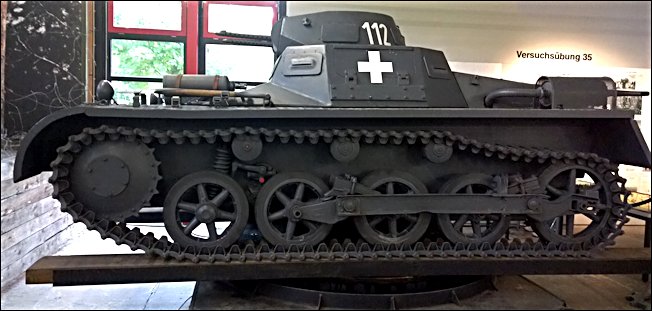
German Panzer I Ausf. A tank Panzerkampfwagen at the Deutsches Panzermuseum in Munster, Germany
How were Panzer Mark I tanks made in secret?
In 1927, whilst still under the de-military restrictions following the First World War, the German High Command placed tenders for, what it called a Grosstraktor (big tractor), Leichttractor (light tractor) followed by a Kleintracktor (small tractor). These objects were nothing to do with agricultural tractors. These things had guns. They were code names for tractors. Some were developed in secret in the Soviet Union.
The Kleintracktor would become the Panzer Mark I light tank. It was produced by Krupp and only armed with machine-guns. It was intended for infantry support, reconnaissance and police roles, not tank on tank battles. The caliber of the machine-guns could go through the armour of some British and French light tanks like the Vickers Light Tank Mark VI and the Renault FT. It had to run away if it came across a heavily armoured British Matilda II of French Char B1-bis tank.
To keep up with the deception Krupp took short cuts in the Panzer I tank’s development by buying and adapting the existing British Carden-Lloyd tractor chassis. Without knowing it the British Arms Industry helped kick start the German Army’s tank development program.
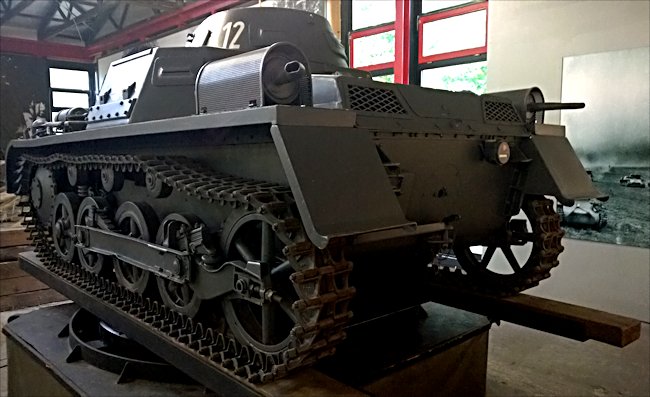
German Panzer I Ausf. A tank Panzerkampfwagen at the German Tank Museum in Munster, Germany
The Panzer Mk I tank comes out of hiding.
The first public showing of the new Panzer I tank happened in 1935 when an eight tank wide row of Panzer I tanks thundered across the parade ground at the Nuremberg Nazi Party Rally, the Reichsparteitag. It announced to the world that the deception was over.
On 2nd September 1936 forty one Panzer MkI tanks were lashed down in the hold of two ships bound for Spain and the Spanish Civil War. There were 180 tank crew members on board along with the Panzer Regiment tank mechanics. All men were single and volunteers. They became part of the German Condor legion that was there to support the Fascist side of General Franco.
The Soviet Union joined the International Brigade and sent tanks to help the Communist side. The Russian T-26 and T-28 tanks were a very unpleasant shock for the German tank crews. These Soviet tanks outclassed the German Panzers in both firepower and armour.
Lots of lessons were learned that would be put into action during World War Two. They found out that using their tanks in a ‘hull down’ position, only exposing the tank’s turret, increased survivability. In chance encounters or when attacking, movement helped increase the chances of not being hit. Tanks needed infantry support during an attack. When the Panzers drove too fast for the infantry to keep up they normally suffered high loses. Many tanks were destroyed by enemy soldiers throwing petrol bombs at the tracks of the light tanks. The rubber on the wheels caught fire, the tank was immobilised and the heat became so hot inside the tank that the crew had to bail out.
Working as a team with other military units was the key to success especially as the tanks had poor fire power. The Germans found out that their 37mm field gun worked well in an anti-tank role and its shells could penetrate the armour of the Russian tanks. Well placed anti-tank mines were also very effective.
The French opinion of the new German tanks can be gleaned from an article in the newspaper L’intransigent on 20th April 1937. "The German tanks were a major disappointment, two man crew, 50 kilometers per hour, two machine-guns and almost worthless armour." No wonder the French were complacent about the abilities of the French tanks to meet the threat from the German Panzer Divisions in 1939. Their heavy tanks like the Char B1-bis had a 75mm cannon and 60mm of frontal armour that even the German 37mm field gun could not penetrate.
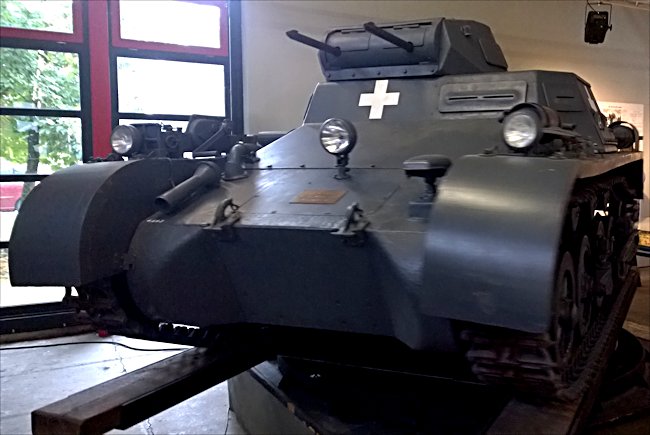
German Panzer I Ausf. A tank Panzerkampfwagen at the German Tank Museum in Munster, Germany
Lessons learnt during the occupation of Austria
The Germans found out during the peaceful occupation of Austria that the Panzer I was prone to mechanical breakdown on long drives. Panzer Commander Leutnant Helmut Ritgen recalled, "It often coughed and spluttered to a halt when rattling along the road. This meant dismounting, opening the access hatches, and trying to start the engine up again. Changing the spark plugs or operating the fuel pump by hand, at the cost of blackened burnt and bruised fingers and faces. Sometimes we got the best started again with a loud bang: otherwise it was taken away by the recovery team."
One of the most important lessons learnt by the generals during the mass movement of tanks into Austria was about the logistics of supplying so many thirsty vehicles with enough fuel. They nearly ran out and had to order all the Austrian petrol stations to remain open and get more supplies delivered. They realised that during future offensives they would not be able to rely on getting fuel locally. They introduced the use of a petrol can that would be known as the ‘Jerry Can’. It would enable tank crews to fill up their own vehicles with fuel and not rely on a petrol tanker and a fuel hose. Each Panzer Division from that point on would be responsible for ensuring that they had enough supplies of fuel, food and ammunition to maintain itself for 3 to 5 days. This is a lesson the French failed to understand and one of the reasons many of their superior tanks were just abandoned for lack of fuel and ammunition during the Battle of France.
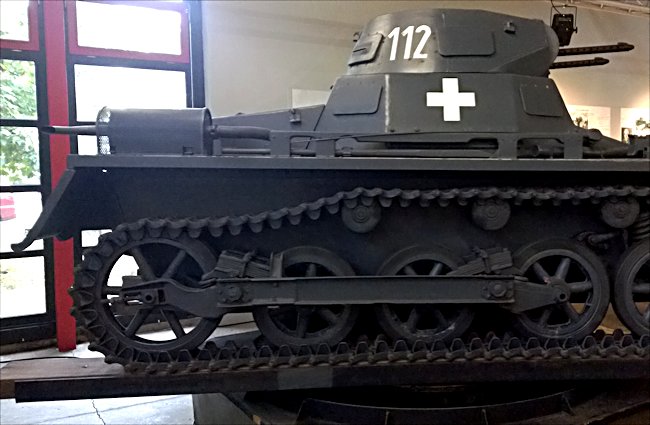
German Panzer I Ausf. A tank Panzerkampfwagen at the German Tank Museum in Munster, Germany
The Panzer I goes back to Germany
The German Tank Museum arranged with the French Tank Museum to temporary swap two tanks. Their Panzer I tank went to Saumur whilst a WW1 Renault FT tank went to Munster. In the photograph below it is great to be able to compare the size of the Panzer I next to the French Tank Museum's huge King Tiger tank.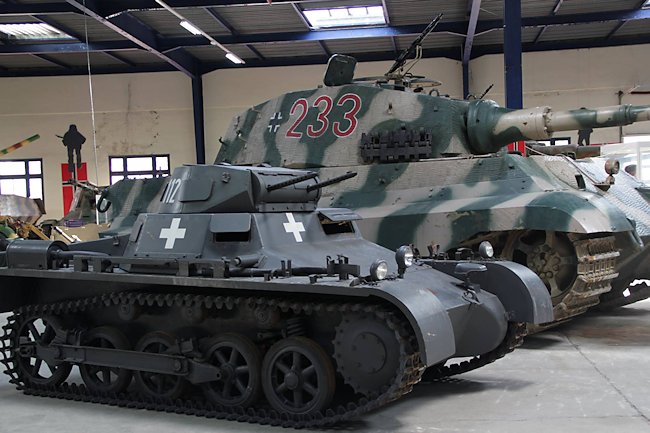
German Panzer I Ausf. A tank next to the French Tank Museum's King Tiger tank (Photo - French Tank Museum, Saumur)
Poland causes problems for the Panzer Mark I Tank
When orders came through for the invasion of Poland the Panzer units were still training new recruits, re-equipping and reorganising. They only had 87 of the Panzer Mark IIIs and 197 Mark IV tanks. German tank production was competing with the growing Luftwaffe air force and the Kriegsmarine Navy. The German high command were acutely aware of their Panzer Regiment limitations. For examples Panzer Regiment 5, which was one of the earliest tank units to be established, only had three Panzer IIIs and nine Panzer IV tanks. It did have 63 Panzer I and 77 Panzer II tanks.
The Panzer I light tanks had been ordered as a measure to provide driver training for the newly established Panzer Regiment tank crews. A German senior officer dolefully wrote in a letter, "Nobody in 1932 could have guessed that one day we should have to go into action with this little training tank." The future Tiger Tank ace Otto Carius called this little tank, 'the runt of the litter'. It was manufactured by the Krupps company. This little tank was also given the nickname of 'Krupp's sports car'. Many of these tanks were destroyed by the Polish 37 mm anti-tank gun. Its shells went straight through the tank's thin armour.
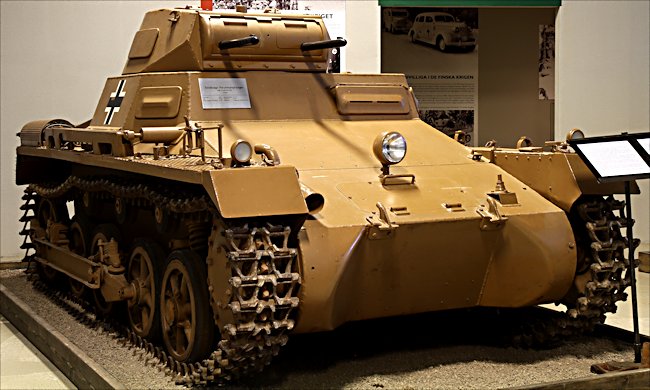
This preserved German Panzer I Ausf. A tank in Afrika Korps desert camouflage can be found in the Arsenalen Swedish Tank Museum, Strangnas by the E20 motorway. Their website is arsenalen.se
Where can I find other preserved Panzer I Tanks?
- Pz Kpfw I Ausf. A - Akerhus Fort Norway
- Pz Kpfw I Ausf. A - Arsenalen Swedish Tank Museum, Strangnas, Sweden
- Pz Kpfw I Ausf. A - Munster Panzer Museum, Germany
- Pz Kpfw I Ausf. A - El Goloso Museum Spain
- Pz Kpfw I Ausf. A - The Collings Foundation, Stow, MA, USA
- Pz Kpfw I Ausf. B - El Goloso Museum Spain
- Pz Kpfw I Ausf. B - Tank Museum in Kubinka Russia
- Pz Kpfw I Ausf. B - Military Technical Museum, Chernogolovka, Russia
- Pz Kpfw I Ausf. B - Ordnance Museum, Fort Lee, VA, USA
- Pz Kpfw I Ausf. F - Kalemegdan Military Museum Serbia
- Pz Kpfw I Ausf. F - Tank Museum in Kubinka Russia
- Pz Kpfw I Reproduction - Private Collection in Poland
- Source - Pierre-Oliver Buan - http://the.shadock.free.fr/Surviving_Panzers.html
WW2 tank books

